A Numerical Analysis of an Innovative Flow Ripple Reduction Method for External Gear Pumps
Abstract
1. Introduction
2. The Tool: EgeMATor
2.1. Overview
2.2. The Surface Tool
2.3. The Hydraulic Model
3. Three-Dimensional CFD Numerical Model
- The pressure at inlet port: 0 bar
- The pressure at outlet port variable in the range 230–350 bar
- The fluid is hydraulic oil, ISO VG46
- Variable dynamic viscosity
- Variable liquid bulk modulus (linearly dependent with pressure)
- Oil Temperature: 313 K
4. Results Comparison
- EgeMATor standard (later called EgeMATor STD) are the results from the lumped parameter model in standard condition, where sealing conditions (gears’ teeth contact, gears—housing micromotion) are strictly respected.
- EgeMATor (3D CFD) are the results from the lumped parameter model with imposed clearances to match the 3D CFD simulating conditions (no perfect sealing).
- 3D CFD are data referring to the three-dimensional CFD numerical model with minimum clearance to respect a CFD simulation context.
4.1. Outlet Flow Ripple
4.2. Gi and Ni Pressure Distributions
5. Alternative Capacitive Volumes (ACV)
5.1. The ACV Idea
5.2. The ACV’s β Angle Optimization
- Optimization technique: NLPQL
- Relative gradient step: 0.0001
- Desired final accuracy: 0.001
5.3. Final Results
6. Conclusions
Author Contributions
Funding
Institutional Review Board Statement
Informed Consent Statement
Data Availability Statement
Acknowledgments
Conflicts of Interest
Nomenclature
| Acronyms | |
| Name | Descriptions |
| ACV | Alternative Capacitive Volumes |
| CAD | Computer-Aided Design |
| CFD | Computational Fluid Dynamic |
| CPU | Central Processing Unit |
| DXF | Drawing Exchange Format |
| EDGM | Equilibrium Dissolved Gas Model |
| EgeMATor | External Gear Machine Multi Tool Simulator |
| EGMs | External Gear Machines |
| EGP | External Gear Pump |
| GIF | Graphical Interchange Format |
| ISO | International Organization for Standardization |
| NCG | Non-Condensable Gas |
| NLPQL | Non-Linear Programming by Quadratic Lagrangian |
| NSGA-II | Non-dominated Sorting Genetic Algorithm II |
| NUG | Non-Uniformity Grade |
| RANS | Reynolds Average Navier-Stokes |
| Symbols | |
| Name | Descriptions |
| Ce | Cavitation evaporation coefficient |
| Dv | Diffusivity of the vapor mass fraction (m2/s) |
| Dg,d | Diffusivity of the dissolved NCG (m2/s) |
| fd,equil,ref | Equilibrium mass fraction of the dissolved gas at the reference pressure |
| fg | Mass fraction of free NCG |
| fg,d | Free NCG mass fraction |
| fg,f | Mass fraction of dissolved NCG |
| fg,specified | User-specified value |
| fv | Mass fraction of the vapor |
| Surface normal of the surface σ | |
| p | Pressure (Pa) |
| pd,equil,ref | Reference pressure for the dissolved gas equilibrium mass fraction (Pa) |
| pv | Phase-change threshold pressure (Pa) |
| Q | Flowrate (L/min) |
| Re | Vapor generation rate |
| Rc | Vapor condensation rate |
| Sg,d | Source of dissolved NCG (kg/m3) |
| V | Volume (m3) |
| Fluid velocity vector (m/s) | |
| VE | Estimated pump displacement (m3/rev) |
| VG,i | i-th volume of the driving gear (m3) |
| VN,i | i-th volume of the driven gear (cm3) |
| t | Time (s) |
| zT | Number of teeth |
| Greek Symbols | |
| β | Angle on the ACV |
| βk | Fluid bulk modulus |
| μt | Turbulent viscosity (Pa·s) |
| ρ | Density of mixture (kg/m3) |
| ρatm | Fluid density at atmospheric pressure (kg/m3) |
| ρg | Density of gas (kg/m3) |
| ρl | Density of liquid (kg/m3) |
| σ | Surface of the control volume (m2) |
| σg,d | Dissolved Gas Schmidt number |
| σv | Vapor Schmidt number |
| Ω | Control volume (m3) |
| τ | Time scale (s) |
| Stress tensor | |
| φ | Angle (deg) |
| Δφ | Saving delta angle (deg) |
Appendix A
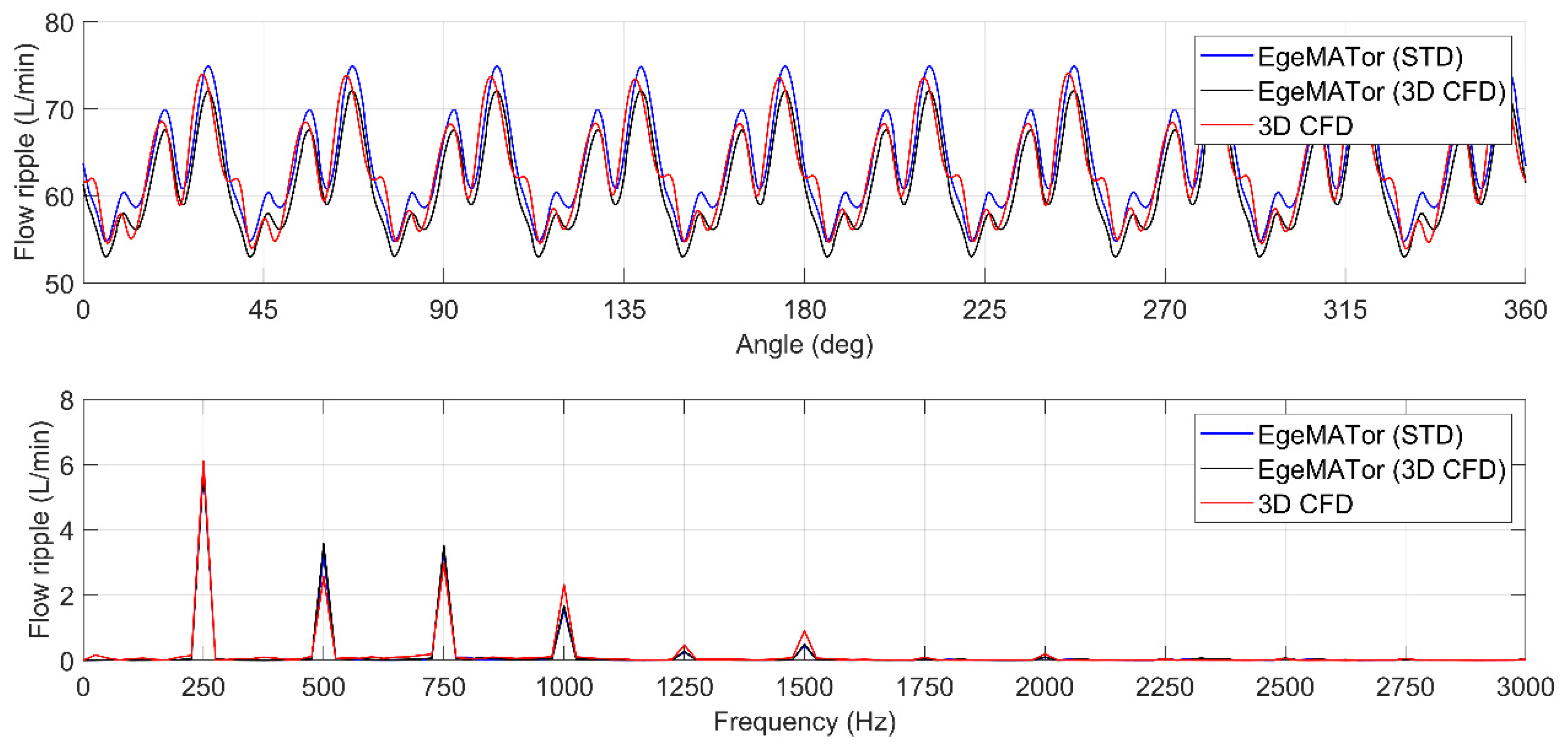
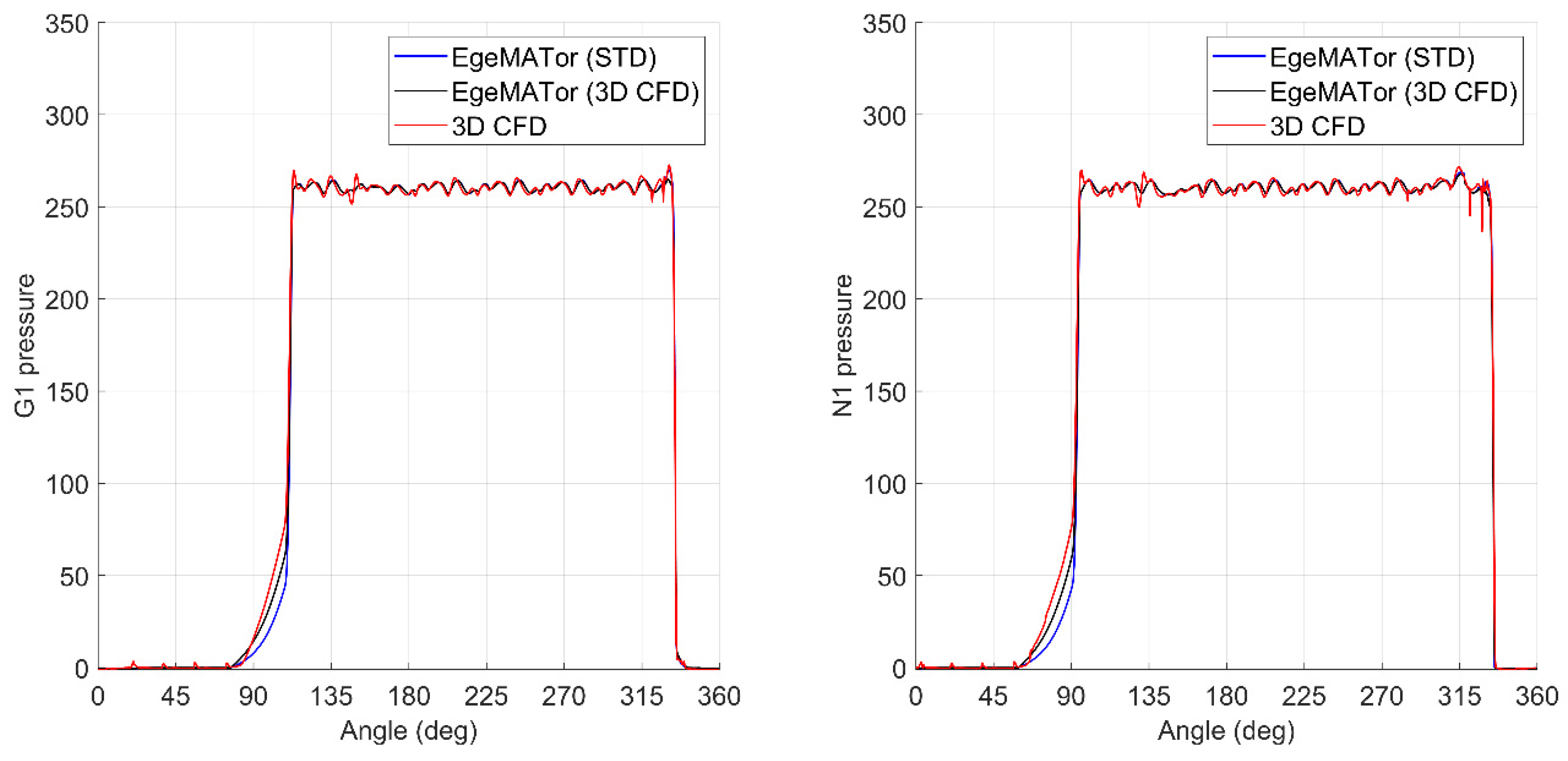
References
- Ivantysyn, J.; Ivantysynova, M. Hydrostatic Pumps and Motors: Principles, Design, Performance, Modelling, Analysis, Control, and Testing; Akademia Books International: New Delhi, India, 2001; ISBN 8185522162. [Google Scholar]
- Rundo, M. Models for Flow Rate Simulation in Gear Pumps: A Review. Energies 2017, 10, 1261. [Google Scholar] [CrossRef]
- Manring, N.D.; Kasaragadda, S.B. The theoretical flow ripple of an external gear pump. J. Dyn. Syst. Meas. Control 2003, 125, 396. [Google Scholar] [CrossRef]
- Vacca, A.; Guidetti, M. Modelling and experimental validation of external spur gear machines for fluid power applications. Simul. Model. Pract. Theory 2011, 19, 2007–2031. [Google Scholar] [CrossRef]
- Zhao, X.; Vacca, A. Formulation and optimization of involute spur gear in external gear pump. Mech. Mach. Theory 2017, 117, 114–132. [Google Scholar] [CrossRef]
- Rituraj, F.; Vacca, A.; Morselli, M.A. Modeling of manufacturing errors in external gear machines and experimental validation. Mech. Mach. Theory 2019, 140, 457–478. [Google Scholar] [CrossRef]
- Riturai, R.; Vacca, A.; Morselli, M.A. Thermal Modelling of External Gear Machines and Experimental Validation. Energies 2020, 13, 2920. [Google Scholar] [CrossRef]
- Zhao, X.; Vacca, A.; Sujan, D. Numerical modeling of a helical external gear pump with continuous-contact gear profile: A comparison between a lumped-parameter and a 3D CFD approach of simulation. In Proceedings of the BATH/ASME 2018 Symposium on Fluid Power and Motion Control, Bath, UK, 12–14 September 2018. [Google Scholar]
- Borghi, M.; Zardin, B.; Specchia, E. External gear pump volumetric efficiency: Numerical and experimental analysis. In Proceedings of the SAE 2014 World Congress and Exhibition, Detroit, MI, USA, 8–10 April 2009. [Google Scholar]
- Zardin, B.; Natali, E.; Borghi, M. Evaluation of the Hydro—Mechanical Efficiency of External Gear Pumps. Energies 2019, 12, 2468. [Google Scholar] [CrossRef]
- Mancò, S.; Nervegna, N. Simulation of an external gear pump and experimental verification. In Proceedings of the JHPS International Symposium on Fluid Power, Tokyo, Japan, 13–16 March 1989. [Google Scholar]
- Zhou, J.; Vacca, A.; Casoli, P. A novel approach for predicting the operation of external gear pumps under cavitating conditions. Simul. Model. Pract. Theory 2014, 45, 35–49. [Google Scholar] [CrossRef]
- Zardin, B.; Borghi, M. Modeling and simulation of external gear pumps and motors. In Proceedings of the 5th FPNI—PhD Symposium on Fluid Power, Krakow, Poland, 1–5 January 2008. [Google Scholar]
- Falfari, S.; Pelloni, P. Setup of a 1D model for simulating dynamic behaviour of external gear pumps. In Proceedings of the SAE 2007 Commercial Vehicle Engineering Congress & Exhibition, Rosemont, IL, USA, 30 October–2 November 2007. [Google Scholar]
- Mucchi, E.; Dalpiaz, G.; Fernandez Del Rincon, A. Elastodynamic analysis of a gear pump. Part I: Pressure distribution and gear eccentricity. Mech. Syst. Signal Process. 2010, 24, 2160–2179. [Google Scholar]
- Strasser, W. CFD investigation of gear pump mixing using deforming/agglomerating mesh. J. Fluids Eng. 2007, 129, 476–484. [Google Scholar] [CrossRef]
- Qi, F.; Dhar, S.; Nichani, V.H.; Srinivasan, C.; Wang, D.M.; Yang, L.; Bing, Z.; Yang, J.J. A CFD study of an electronic hydraulic power steering helical external gear pump: Model development, validation and application. SAE Int. J. Passeng. Cars Mech. Syst. 2016, 9, 346–352. [Google Scholar] [CrossRef]
- Corvaglia, A.; Ferrari, A.; Rundo, M.; Vento, O. Three-dimensional model of an external gear pump with an experimental evaluation of the flow ripple. Proc. Inst. Mech. Eng. Part C J. Mech. Eng. Sci 2020, 1–9. [Google Scholar] [CrossRef]
- Castilla, R.; Gamez-Montero, P.; Ert€urk, N.; Vernet, A.; Coussirat, M.; Codina, E. Numerical Simulation of Turbulent Flow in the Suction Chamber of a Gearpump Using Deforming Mesh and Mesh Replacement. Int. J. Mech. Sci. 2010, 52, 1334–1342. [Google Scholar] [CrossRef]
- Castilla, R.; Gamez-Montero, P.J.; Del Campo, D.; Raush, G.; Garcia-Vilchez, M.; Codina, E. Three-dimensional numerical simulation of an external gear pump with decompression slot and meshing contact point. J. Fluids Eng. 2015, 137, 041105. [Google Scholar] [CrossRef]
- Borghi, M.; Milani, M.; Paltrinieri, F.; Zardin, B. Pressure transients in external gear pumps and motors meshing volumes. In Proceedings of the SAE Commercial Vehicle Engineering Congress, Chicago, IL, USA, 1–3 November 2005. [Google Scholar]
- Frosina, E.; Marinaro, G.; Senatore, A. Experimental and numerical analysis of an axial piston pump: A comparison between lumped parameter and 3D CFD approaches. In Proceedings of the ASME-JSME-KSME 2019 8th Joint Fluids Engineering Conference, AJKFluids, San Francisco, CA, USA, 28 July–1 August 2019. [Google Scholar]
- Olivetti, M.; Monterosso, F.G.; Marinaro, G.; Frosina, E.; Mazzei, P. Valve Geometry and Flow Optimization through an Automated DOE Approach. Fluids 2020, 5, 17. [Google Scholar] [CrossRef]
- Frosina, E.; Senatore, A.; Rigosi, M. Study of a high-pressure external gear pump with a computational fluid dynamic modeling approach. Energies 2017, 10, 1113. [Google Scholar] [CrossRef]
- Frosina, E.; Marinaro, G.; Senatore, A.; Pavanetto, M. Effects of PCFV and Pre-Compression Groove on the Flow Ripple Reduction in Axial Piston Pumps. In Proceedings of the 2018 Global Fluid Power Society PhD Symposium, GFPS 2018, Samara, Russia, 18–20 July 2018. [Google Scholar]
- Singhal, A.K.; Athavale, M.M.; Li, H.Y.; Jiang, Y. Mathematical basis and validation of the full cavitation model. J. Fluids Eng. 2002, 124, 617–624. [Google Scholar] [CrossRef]
- Simerics Inc. Simerics MP+’s User Manual—V 5.0.11; Simerics: Bellevue, WA, USA, 2020. [Google Scholar]
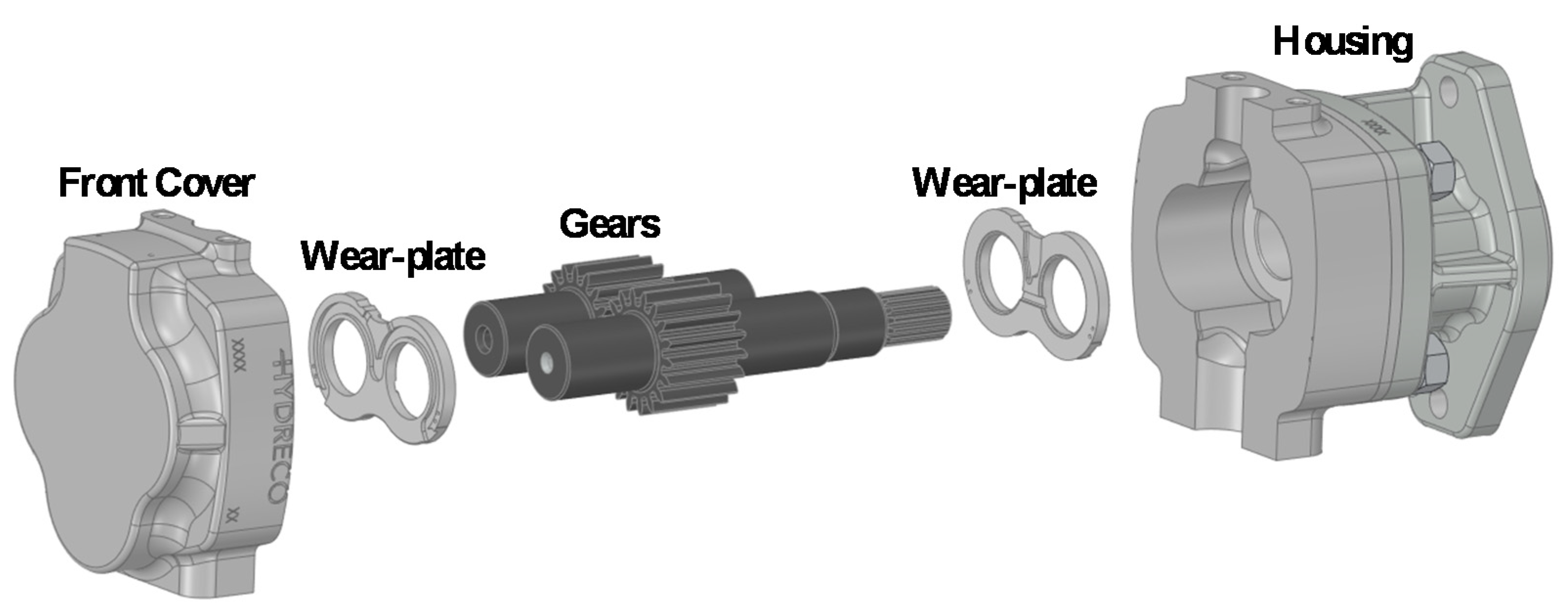
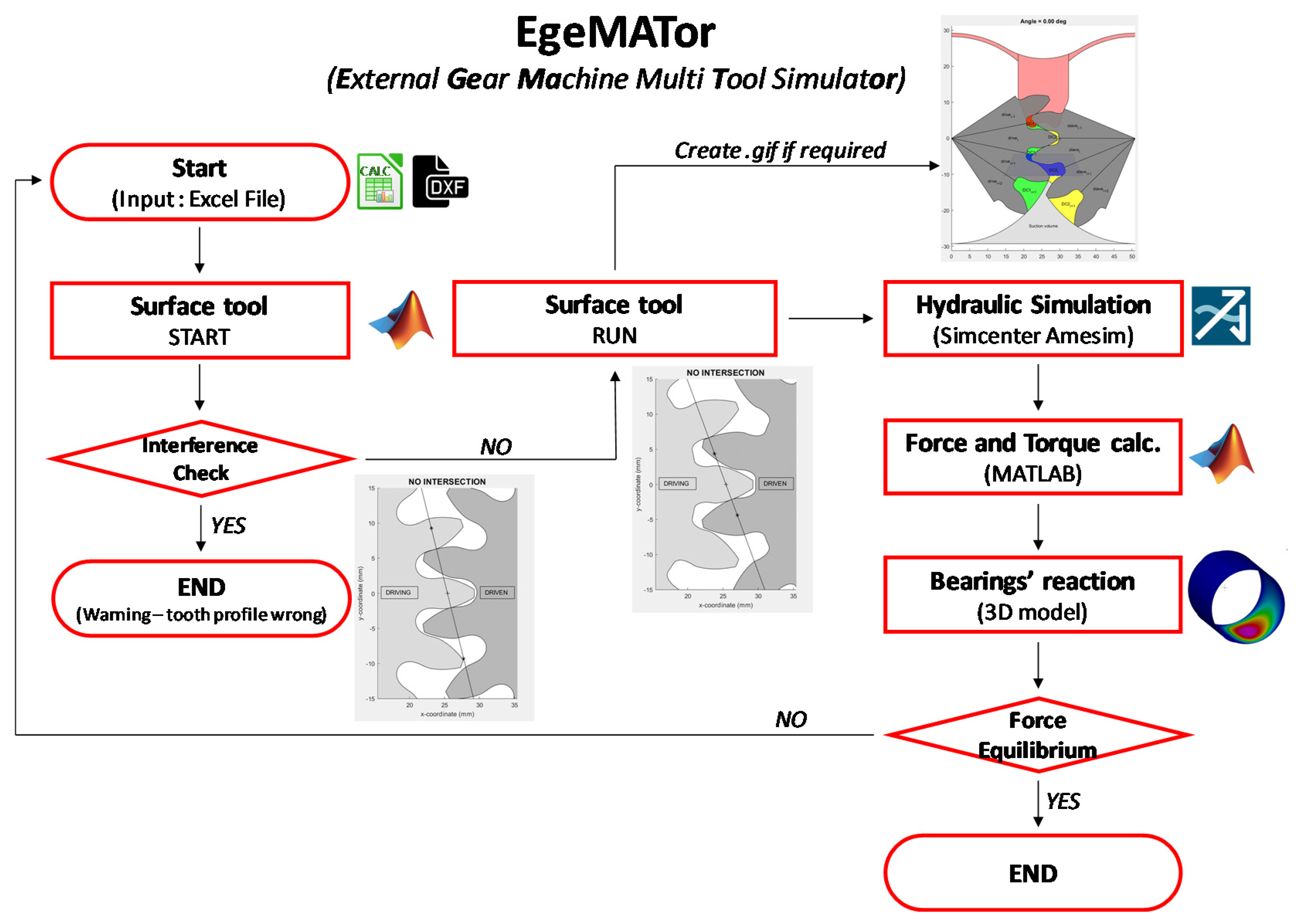
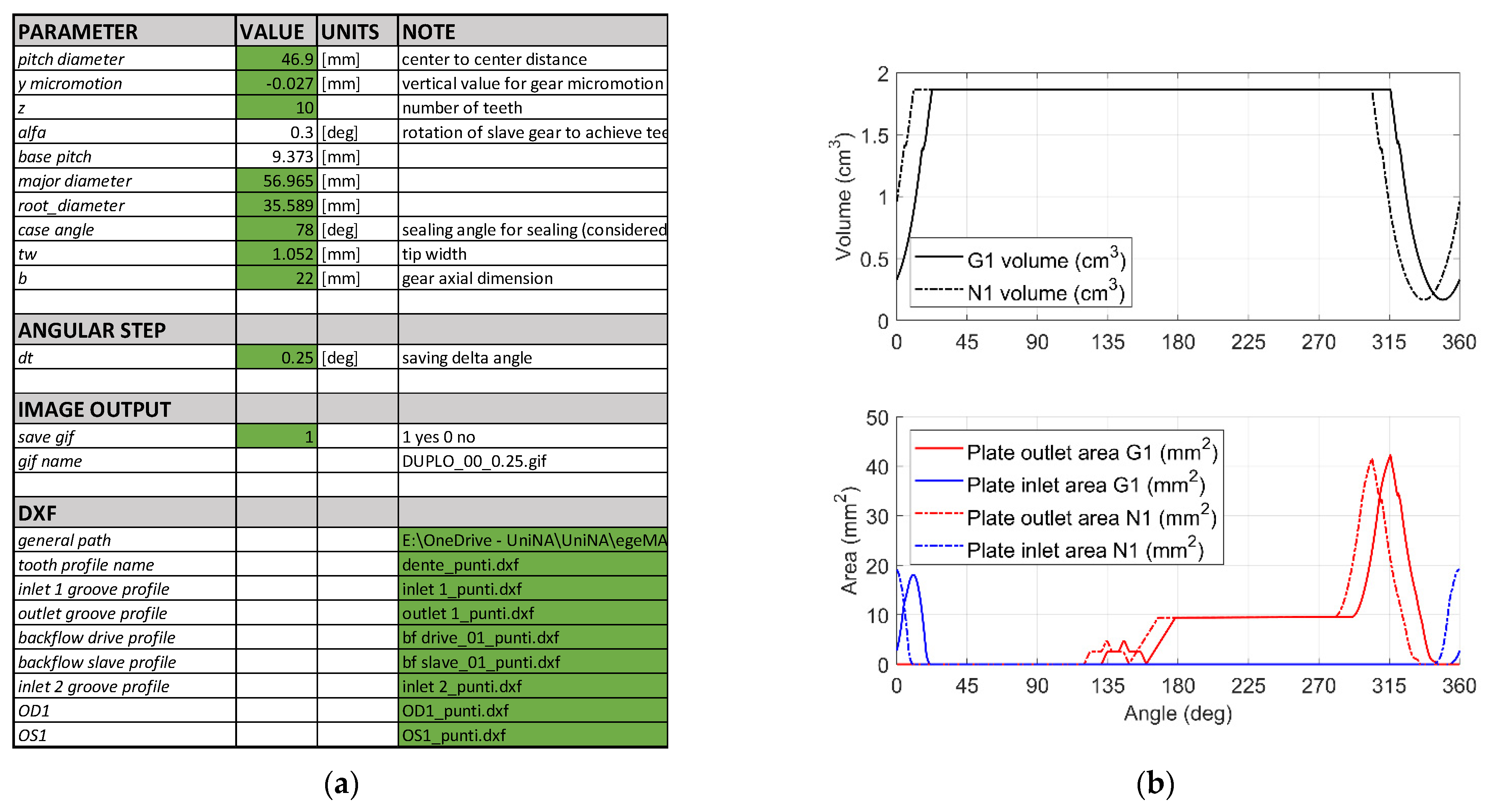
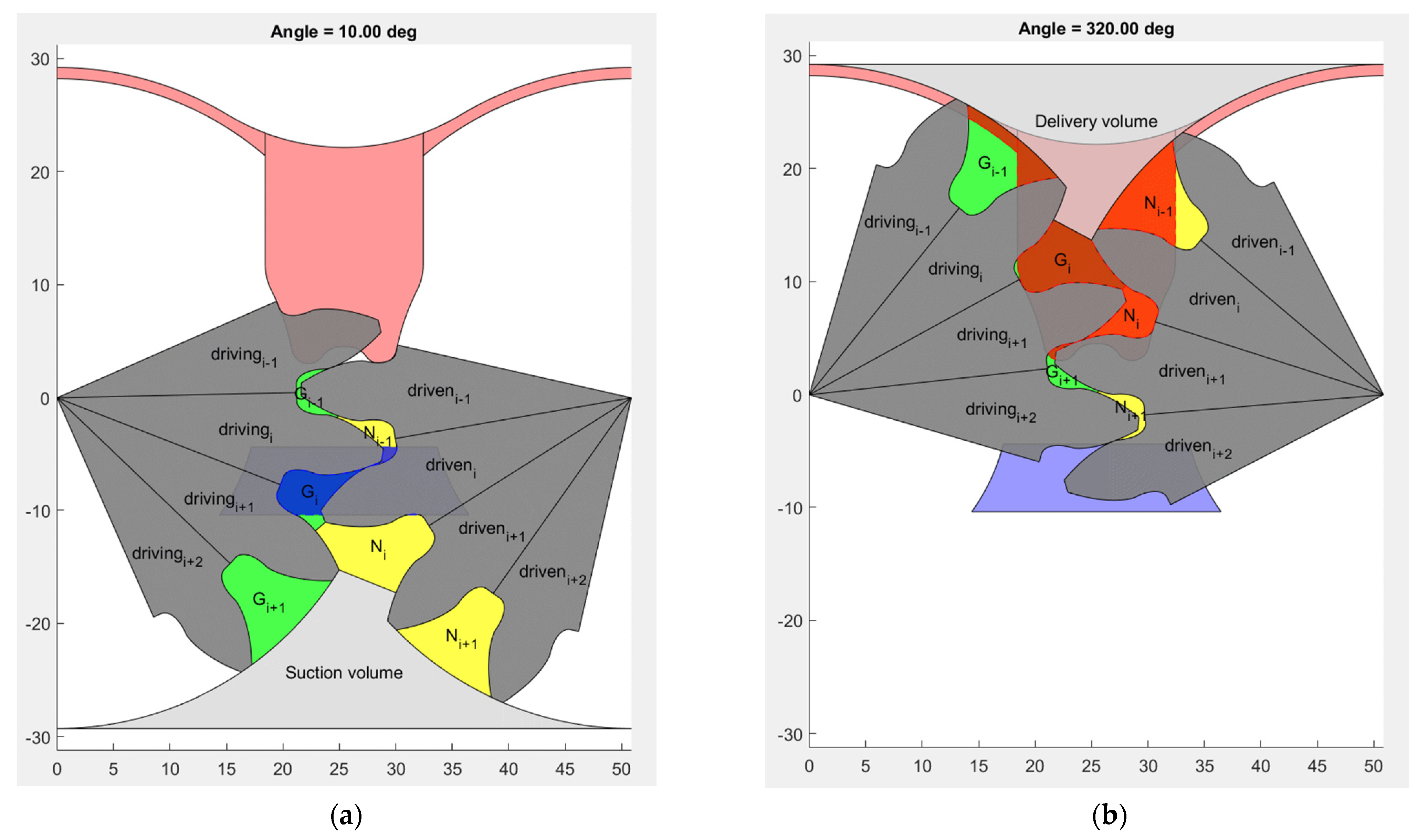


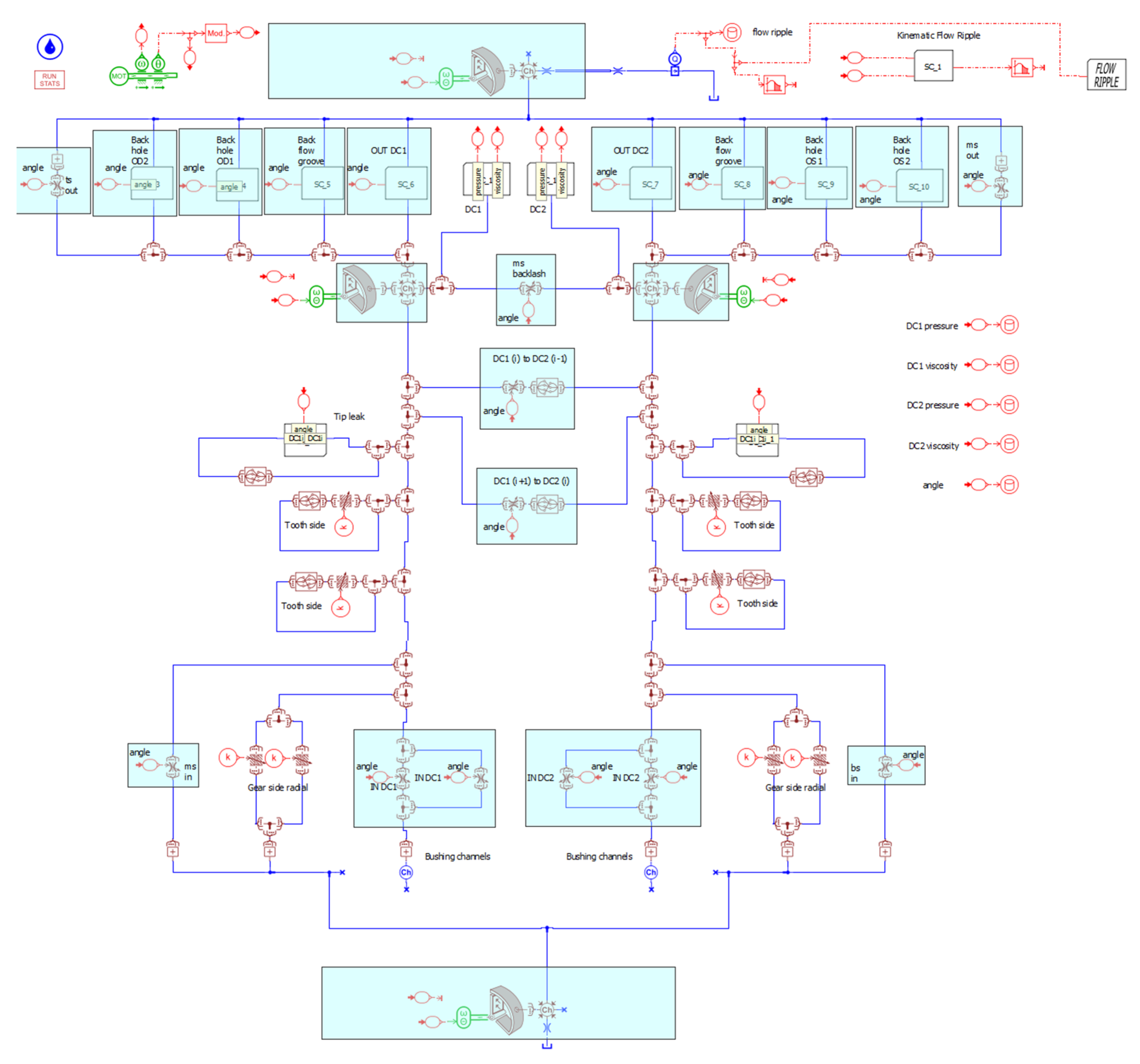
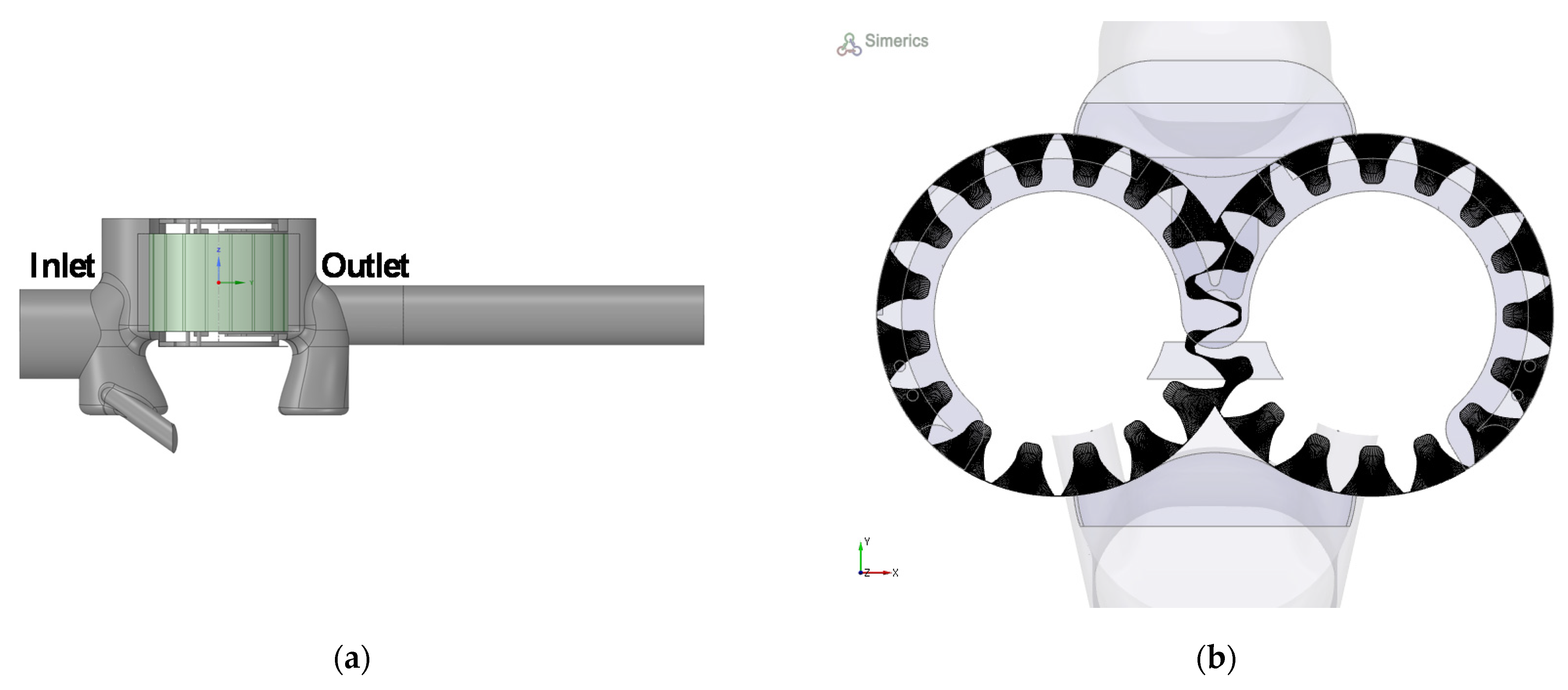
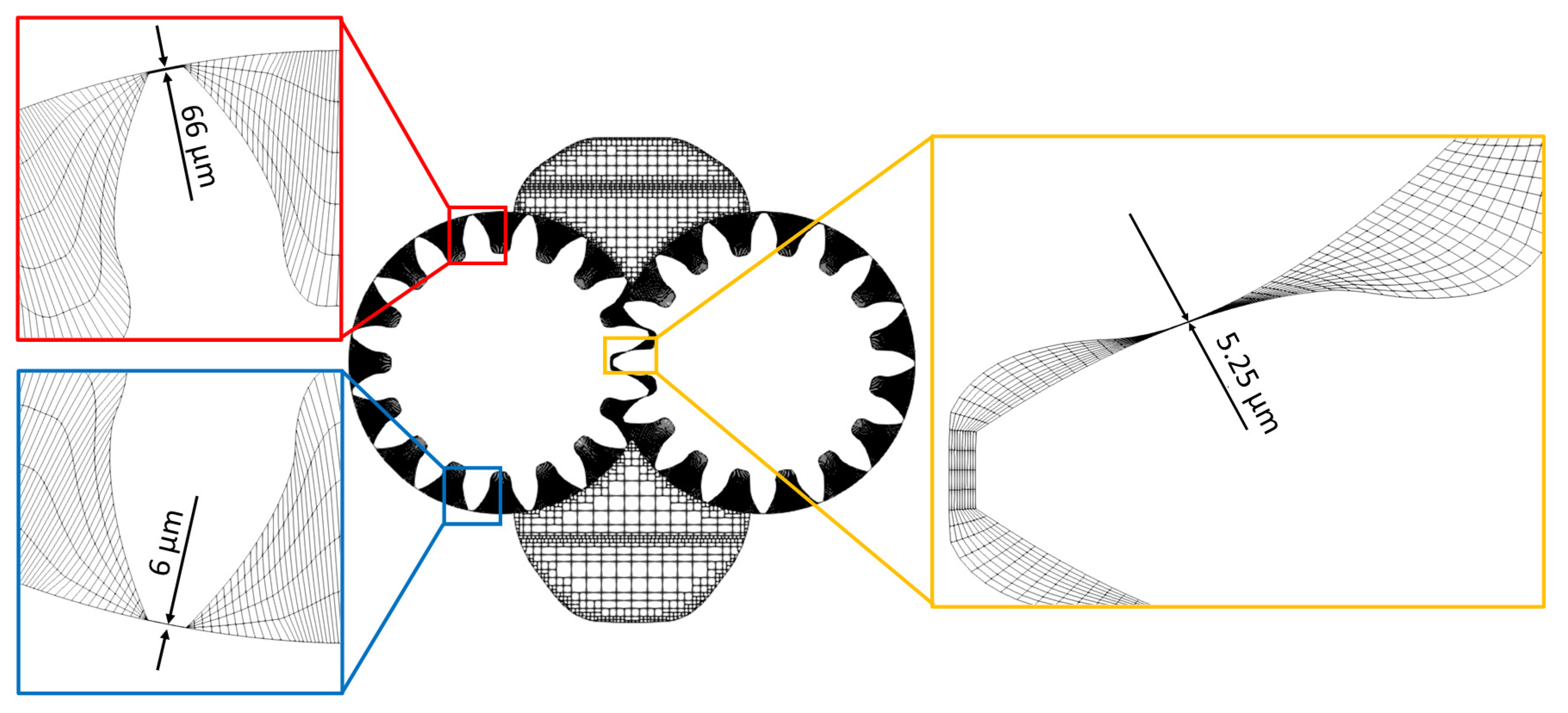
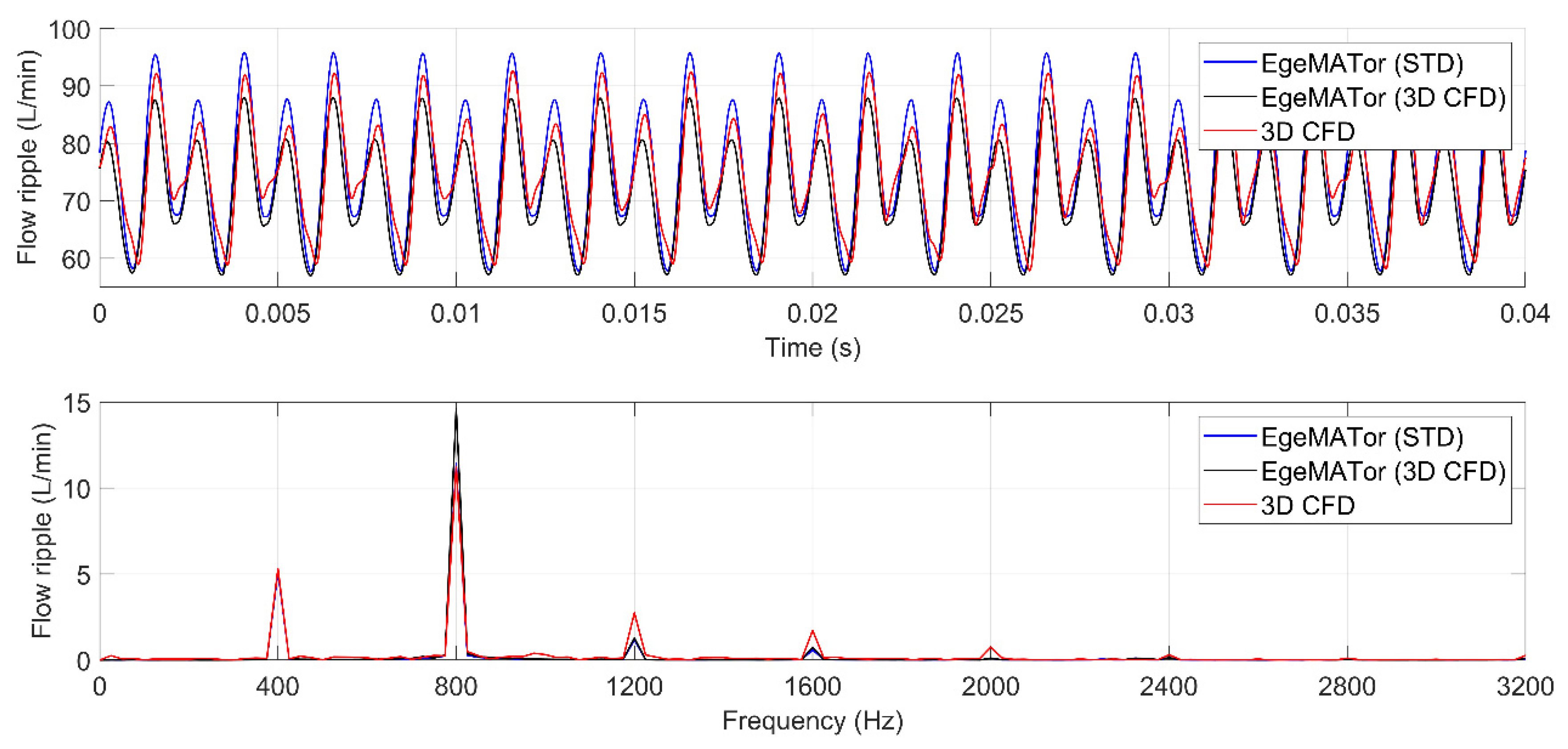

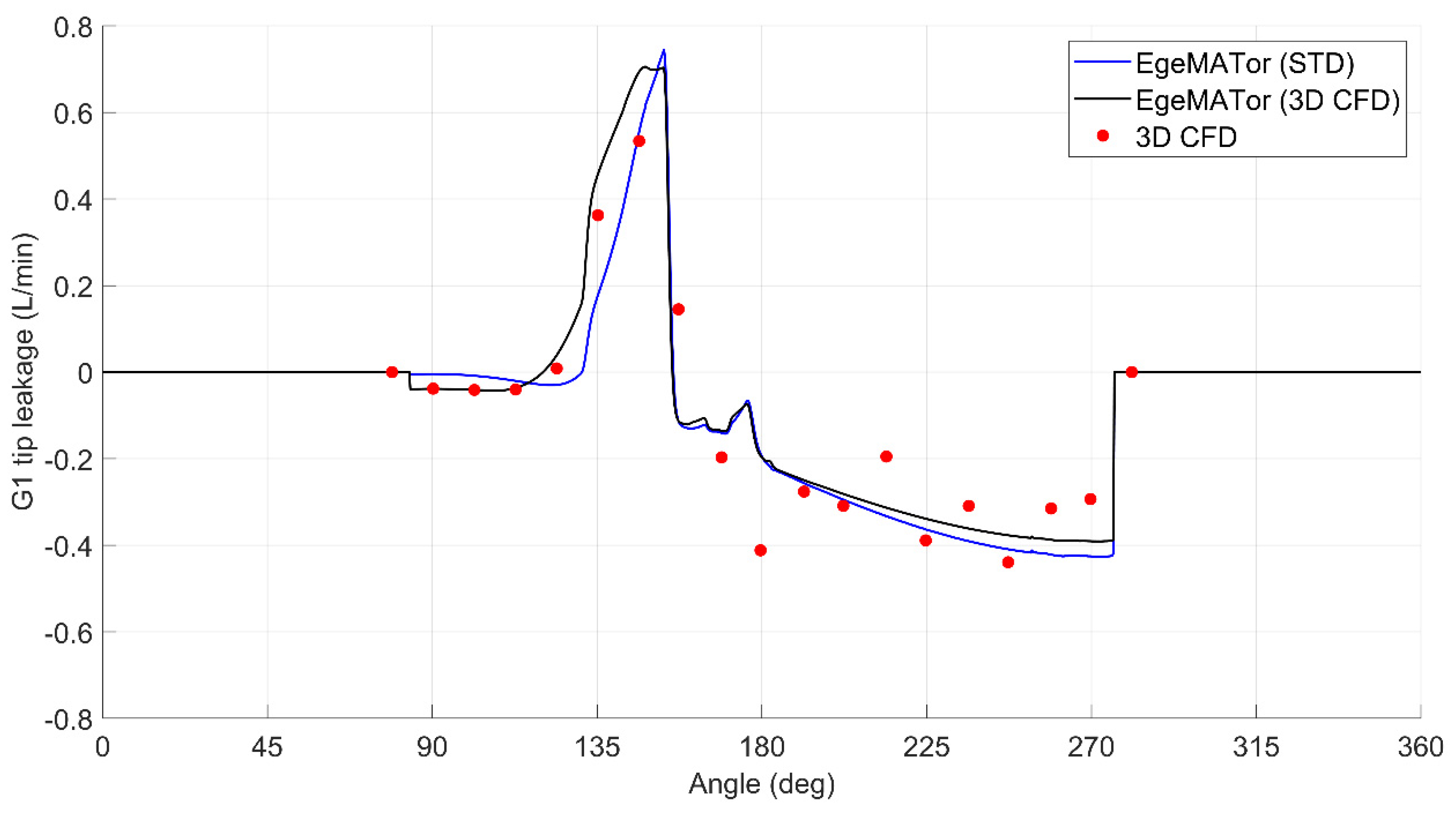



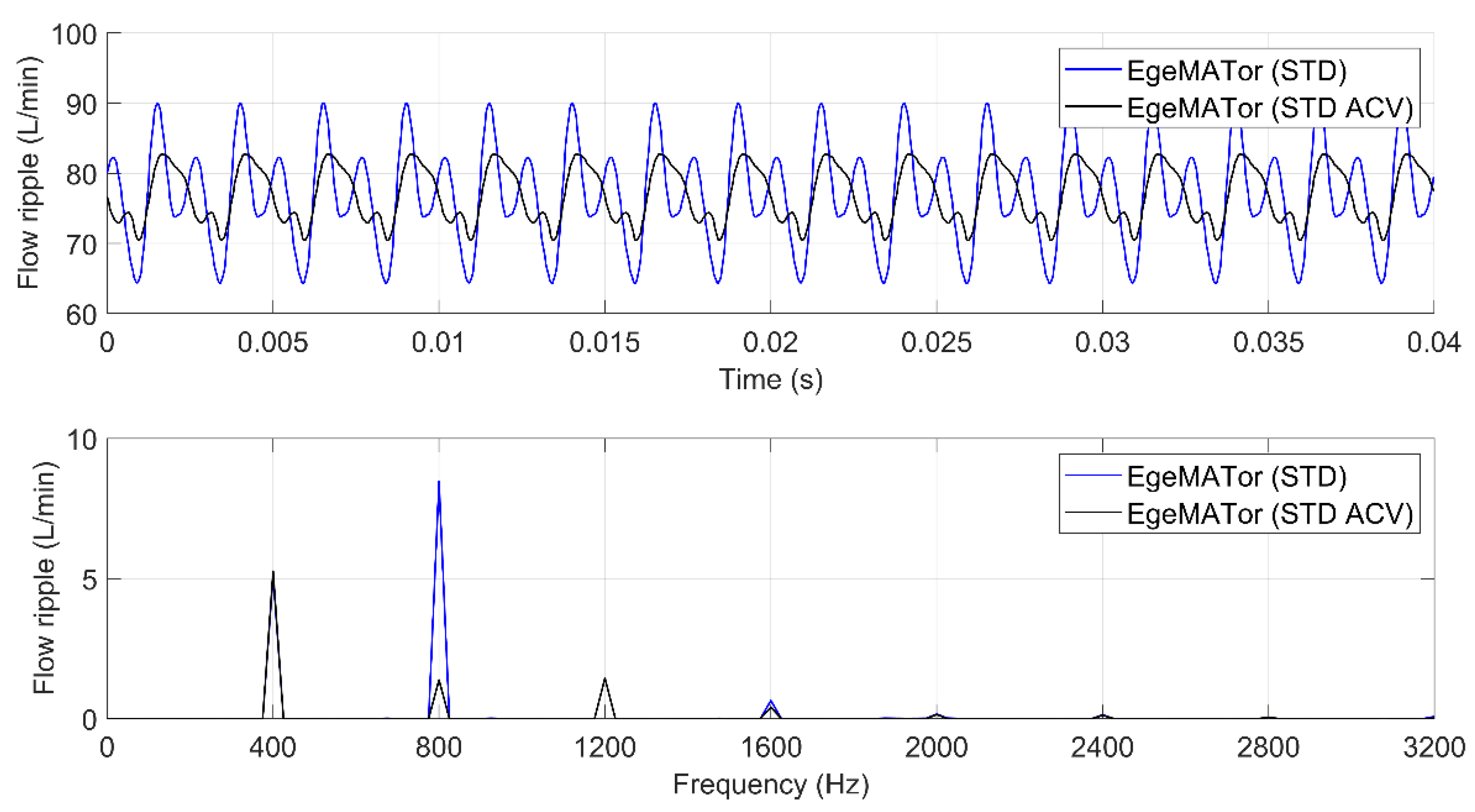
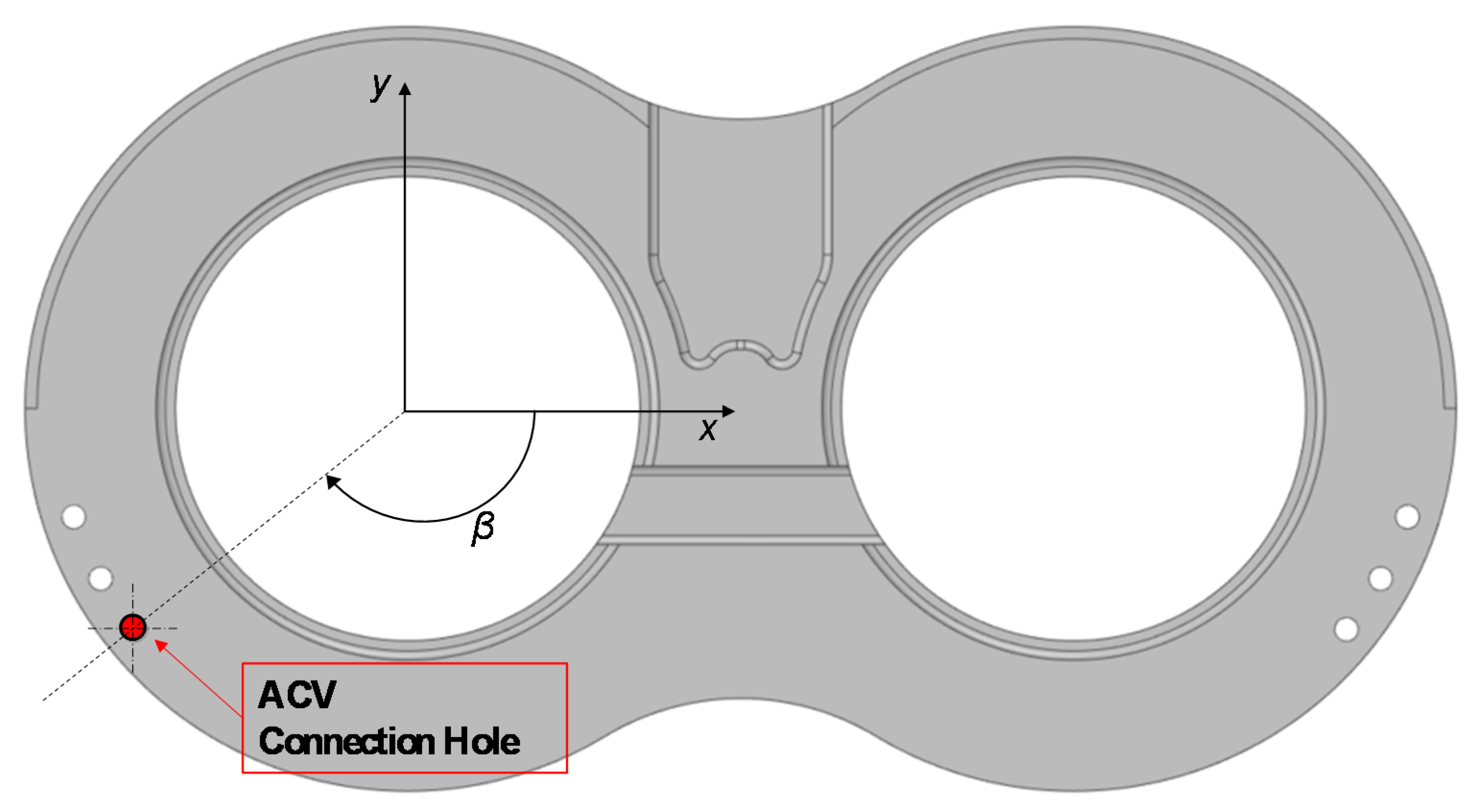
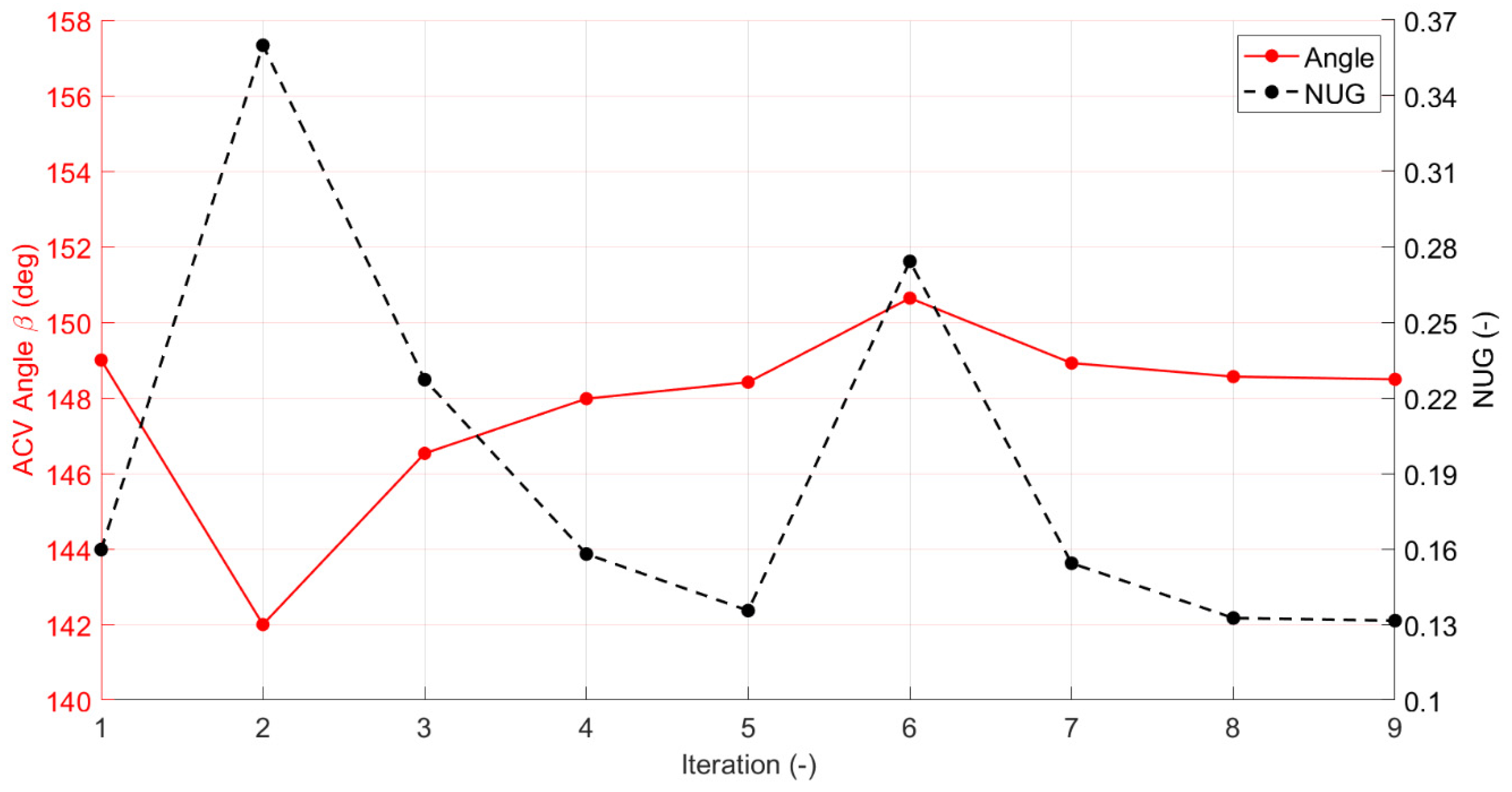
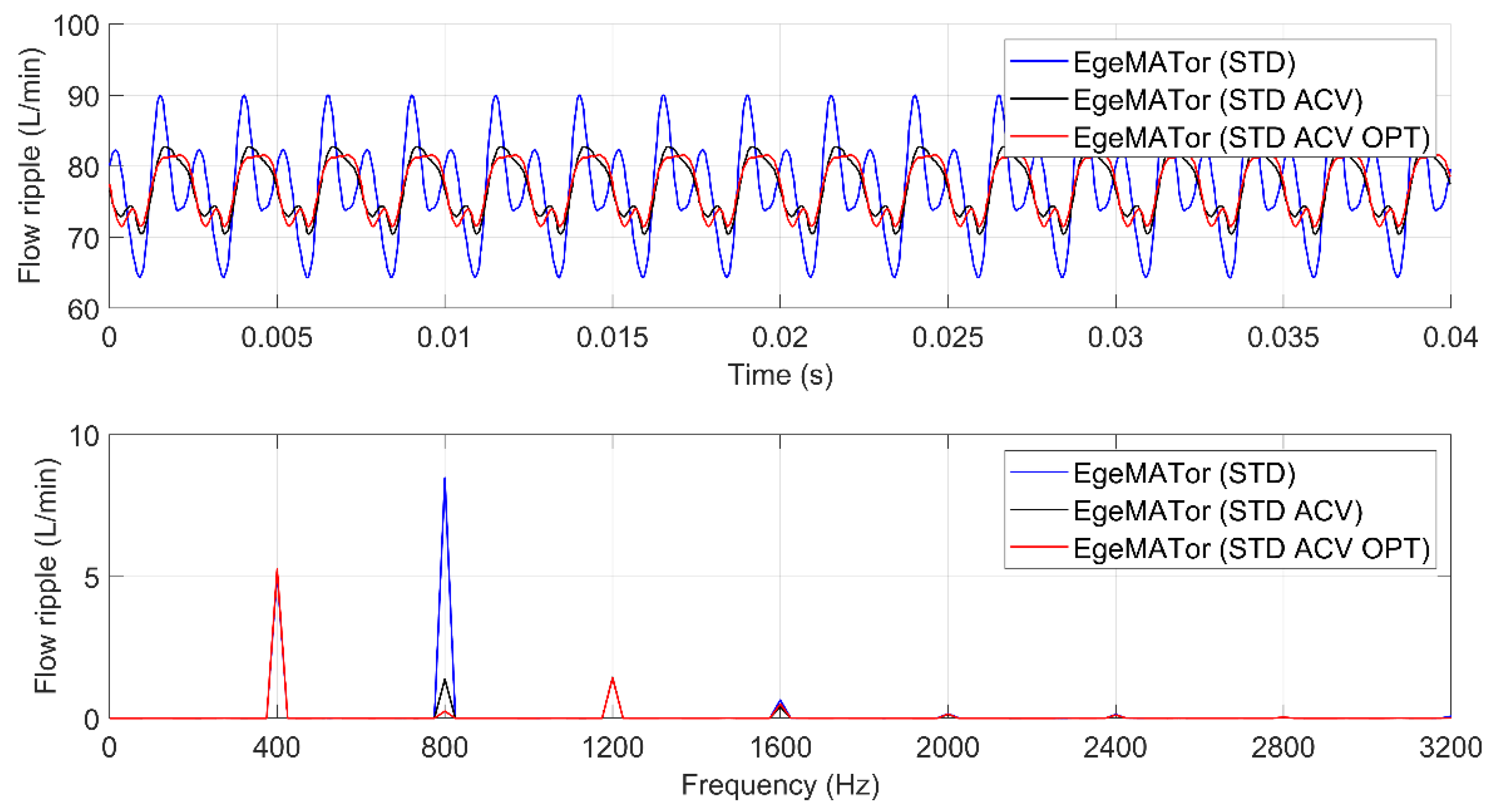
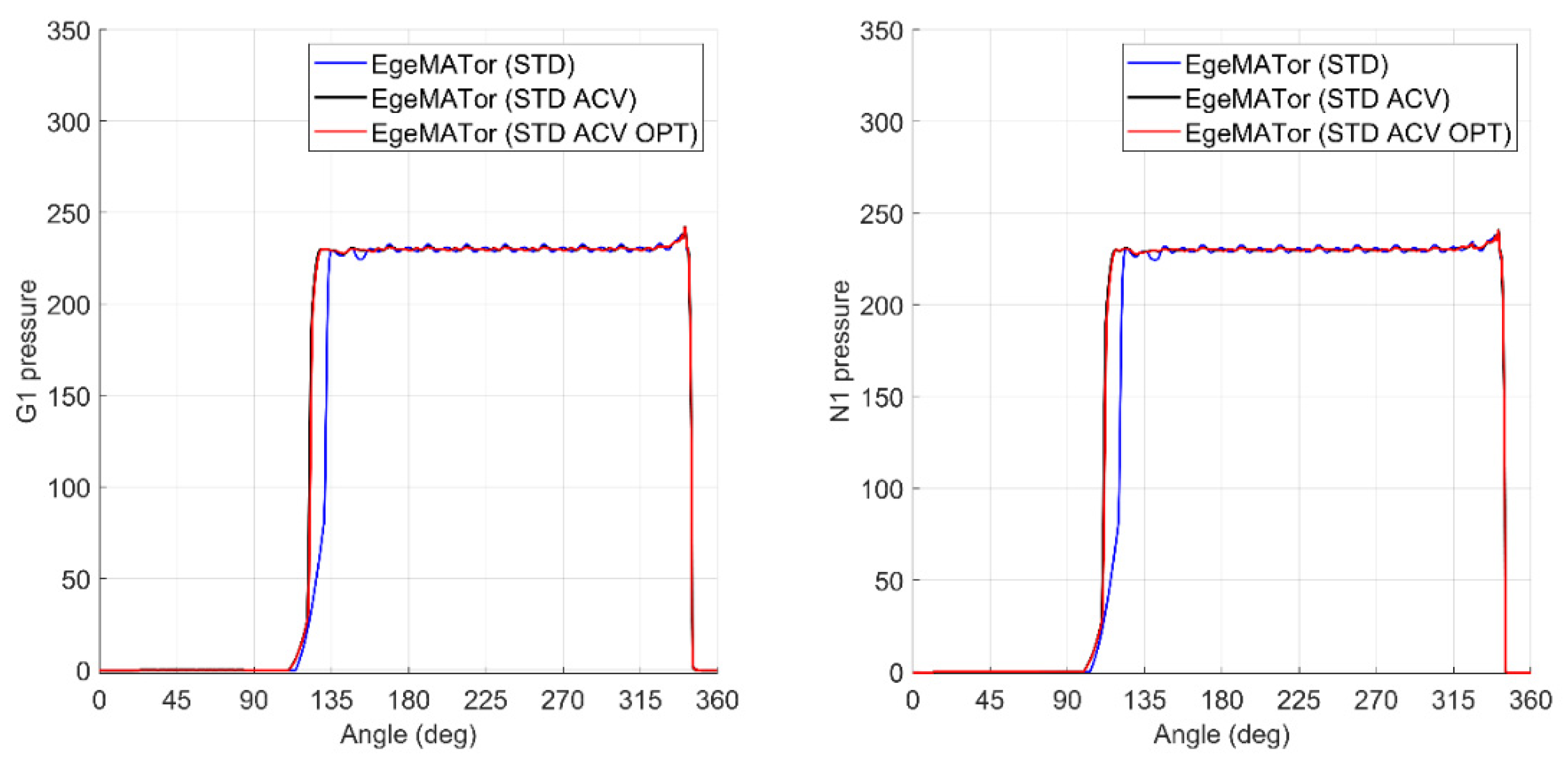
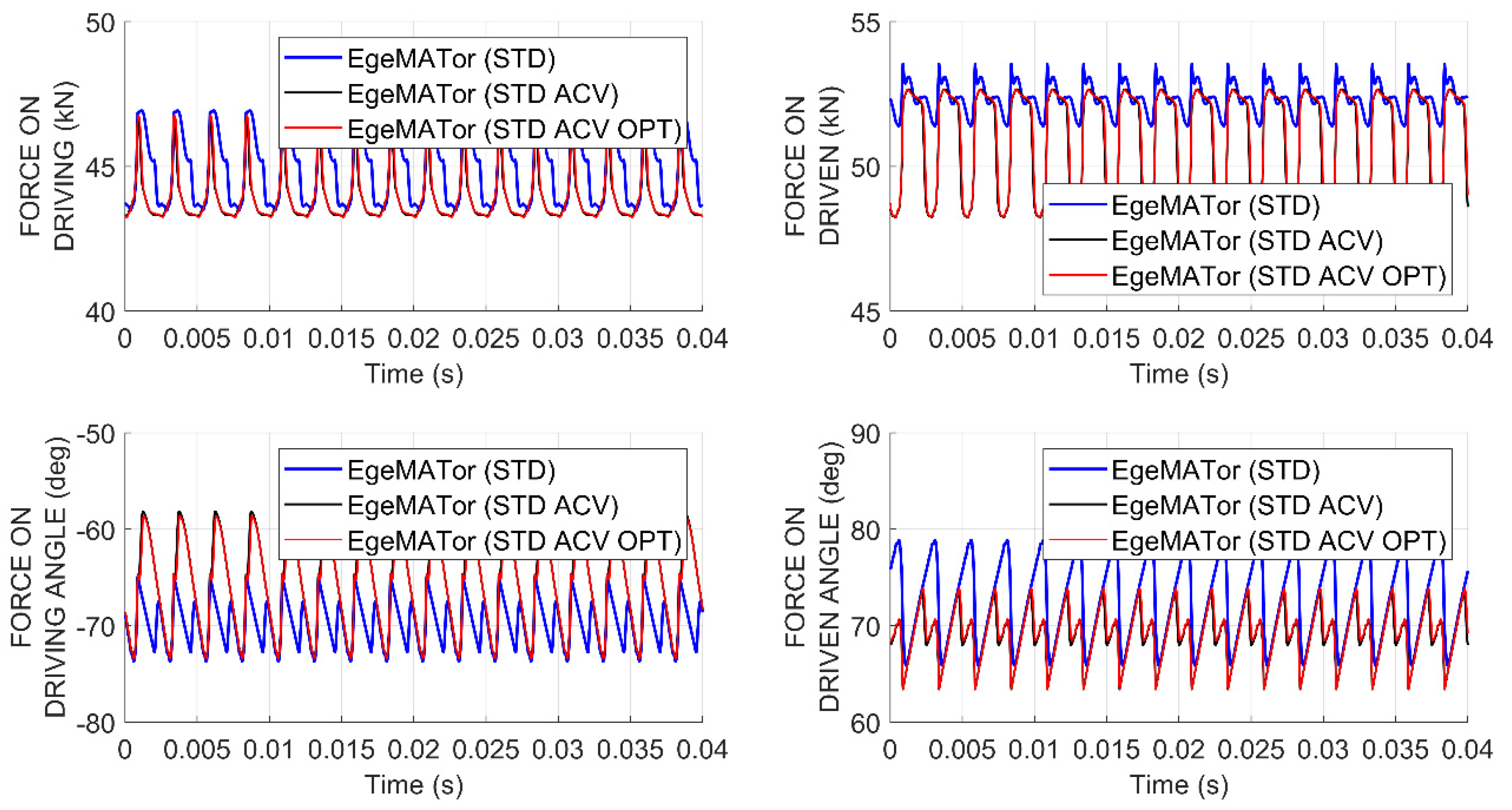

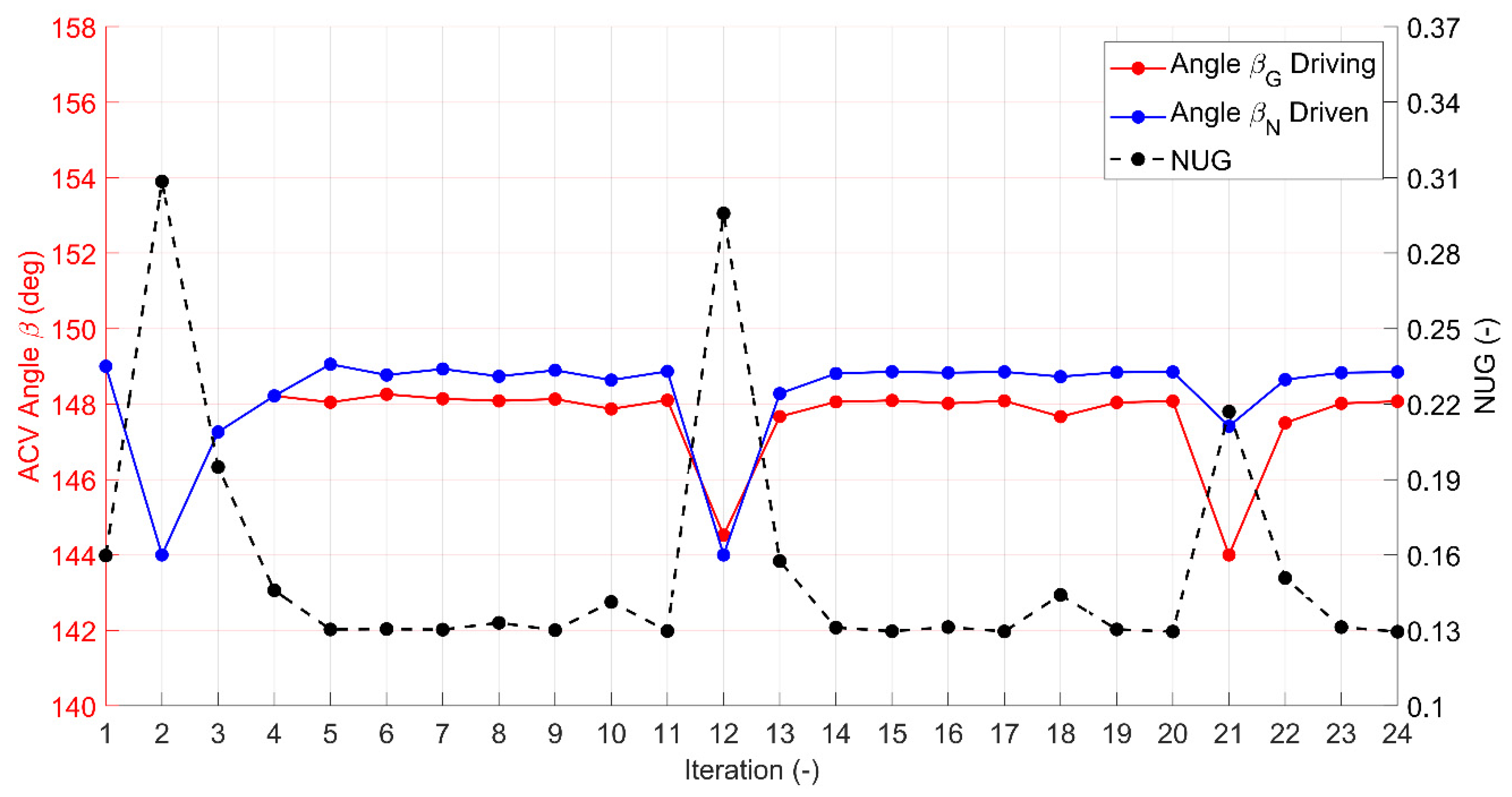
| EgeMATor Model | NUG | Reduction from STD Model |
|---|---|---|
| Standard (STD) | 0.334 | / |
| with ACV (STD ACV) | 0.160 | −52.1% |
| with ACV optimized (STD ACV OPT) | 0.131 | −60.8% |
| Study Number | Pump Speed (rev/min) | Outlet Pressure (bar) | NUG STD (/-) | NUG STD ACV OPT (/) | Variation (%) |
|---|---|---|---|---|---|
| 1 | 1500 | 350 | 0.403 | 0.170 | −57.82% |
| 2 | 1500 | 120 | 0.269 | 0.159 | −40.89% |
| 3 | 800 | 350 | 0.482 | 0.392 | −18.67% |
| 4 | 800 | 120 | 0.308 | 0.234 | −24.03% |
| 5 | 3000 | 350 | 0.340 | 0.363 | +6.76% |
| 6 | 3000 | 120 | 0.317 | 0.345 | +8.83% |
Publisher’s Note: MDPI stays neutral with regard to jurisdictional claims in published maps and institutional affiliations. |
© 2021 by the authors. Licensee MDPI, Basel, Switzerland. This article is an open access article distributed under the terms and conditions of the Creative Commons Attribution (CC BY) license (http://creativecommons.org/licenses/by/4.0/).
Share and Cite
Marinaro, G.; Frosina, E.; Senatore, A. A Numerical Analysis of an Innovative Flow Ripple Reduction Method for External Gear Pumps. Energies 2021, 14, 471. https://doi.org/10.3390/en14020471
Marinaro G, Frosina E, Senatore A. A Numerical Analysis of an Innovative Flow Ripple Reduction Method for External Gear Pumps. Energies. 2021; 14(2):471. https://doi.org/10.3390/en14020471
Chicago/Turabian StyleMarinaro, Gianluca, Emma Frosina, and Adolfo Senatore. 2021. "A Numerical Analysis of an Innovative Flow Ripple Reduction Method for External Gear Pumps" Energies 14, no. 2: 471. https://doi.org/10.3390/en14020471
APA StyleMarinaro, G., Frosina, E., & Senatore, A. (2021). A Numerical Analysis of an Innovative Flow Ripple Reduction Method for External Gear Pumps. Energies, 14(2), 471. https://doi.org/10.3390/en14020471






